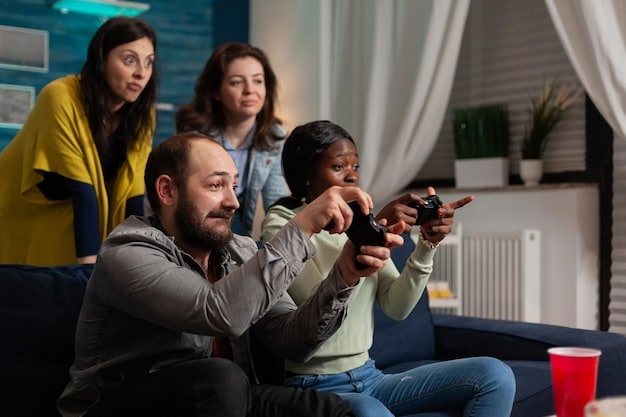Game Localization Challenges: Adapting for Diverse Audiences

Game localization challenges arise as US publishers struggle to adapt content for diverse audiences, facing cultural nuances that impact engagement and market success.
The world of gaming is a global village, but its content often falters when crossing cultural borders. Game localization challenges: Why US publishers are struggling to adapt content for diverse audiences and avoid cultural missteps is becoming a critical issue affecting market reach and player engagement.
Understanding the Game Localization Landscape
Game localization is more than just translating text; it involves adapting the entire game experience to resonate with players from different cultures. This includes everything from altering artwork and character design to rewriting dialogue and adjusting gameplay mechanics.
For US publishers, the importance of effective game localization cannot be overstated. As the gaming market becomes increasingly globalized, the ability to successfully adapt content for diverse audiences is crucial for maximizing market reach and revenue.
The Importance of Cultural Nuances
Cultural nuances play a significant role in how a game is received in different markets. What might be acceptable or even humorous in one culture could be offensive or confusing in another. Understanding these nuances is essential for avoiding costly cultural missteps.
Consider the example of a game featuring religious symbols or themes. While these might be perfectly acceptable in some cultures, they could be highly offensive or taboo in others. Similarly, humor and slang can vary widely from one region to another, making it difficult to create universally appealing content.
- Accurate Translation: Ensuring that the translated text accurately conveys the original meaning and intent.
- Cultural Sensitivity: Avoiding content that could be offensive or inappropriate in certain cultures.
- Understanding Local Regulations: Adhering to local laws and regulations regarding content restrictions and censorship.

Ultimately, successful game localization requires a deep understanding of cultural differences and a commitment to adapting content in a way that resonates with local players.
Key Obstacles in Game Localization
Despite its importance, game localization is fraught with challenges. US publishers often face significant obstacles in adapting their content for diverse audiences, leading to cultural missteps and missed opportunities.
One of the primary challenges is the lack of linguistic and cultural expertise. Many publishers rely on automated translation tools or non-native translators, which can result in inaccurate or awkward translations.
Linguistic Challenges
The process of translating game text can be deceptively complex. It requires not only a strong understanding of both the source and target languages, but also a deep knowledge of the game’s context and themes. Simple errors can lead to confusion or even unintended humor.
Another linguistic challenge is the need to adapt dialogue to match the cultural norms and etiquette of the target audience. This may involve rewriting entire conversations to ensure that they sound natural and appropriate.
Cultural Misinterpretations
Beyond linguistic challenges, cultural misinterpretations can also derail game localization efforts. These can range from subtle errors in tone or style to outright offensive content.
- Inadequate Localization Testing: Failing to conduct thorough testing of the localized game in different cultural contexts.
- Budget Constraints: Limiting the resources available for localization, leading to compromises in quality.
- Time Pressures: Rushing the localization process to meet tight deadlines, resulting in errors and oversights.
To overcome these challenges, US publishers need to invest in comprehensive localization testing and quality assurance.
The Impact of Cultural Missteps
Cultural missteps in game localization can have significant consequences for US publishers. These errors can damage a company’s reputation, alienate players, and ultimately impact sales and revenue.
One of the most immediate consequences of a cultural misstep is negative publicity. In the age of social media, word of a localization error can spread quickly, leading to widespread criticism and calls for boycotts.

Damage to Brand Reputation
Cultural missteps can also damage a company’s long-term brand reputation. Consumers are increasingly sensitive to cultural issues, and a single localization error can tarnish a brand’s image for years to come.
Moreover, cultural missteps can alienate loyal players who feel that their culture has been disrespected or misrepresented. This can lead to a loss of trust and a decrease in player engagement.
Financial Repercussions
In addition to reputational damage, cultural missteps can also have financial repercussions. Poorly localized games are less likely to sell well, leading to lower revenue and potentially significant losses.
- Loss of Market Share: Inability to compete effectively in international markets due to poor localization.
- Increased Development Costs: Need to rework or re-release games after cultural errors are identified.
- Decreased Player Retention: Reduced player engagement and retention due to cultural insensitivity.
To mitigate these risks, US publishers need to prioritize cultural sensitivity and accuracy in their localization efforts.
Strategies for Overcoming Localization Challenges
Fortunately, there are several strategies that US publishers can employ to overcome the challenges of game localization and avoid cultural missteps. These include investing in linguistic and cultural expertise, conducting thorough localization testing, and partnering with local experts.
One of the most effective strategies is to assemble a team of experienced translators and cultural consultants. These professionals can provide valuable insights into the cultural nuances of different markets, helping publishers to adapt their content in a way that resonates with local players.
Investing in Linguistic Expertise
Linguistic expertise is essential for ensuring that the translated text accurately conveys the original meaning and intent. This requires more than just proficiency in the source and target languages; it also demands a deep understanding of the game’s context and themes.
Publishers should also invest in quality assurance testing to identify and correct any errors in translation or cultural adaptation. This testing should be conducted by native speakers who are familiar with the local culture and gaming community.
Conducting Thorough Localization Testing
Localization testing is a crucial step in the game development process. It involves testing the localized game in different cultural contexts to identify any errors or inconsistencies.
- Engage Native Speakers: Recruit native speakers to review and provide feedback on the localized content.
- Test on Different Platforms: Ensure that the game functions properly on all target platforms and devices.
- Monitor Player Feedback: Pay attention to player reviews and comments to identify areas for improvement.
By implementing these strategies, US publishers can improve the quality and effectiveness of their game localization efforts.
The Future of Game Localization
As the gaming market continues to evolve, the importance of game localization will only increase. US publishers that are able to adapt their content for diverse audiences will be well-positioned to succeed in the global marketplace.
One of the key trends in game localization is the increasing use of artificial intelligence (AI) and machine learning. These technologies can automate many of the tasks involved in translation and cultural adaptation, making the process faster and more efficient.
The Role of AI and Machine Learning
AI and machine learning are transforming the game localization industry. These technologies can be used to automate tasks such as translation, voice-over recording, and cultural adaptation.
However, it’s important to remember that AI and machine learning are not a substitute for human expertise. These technologies should be used to augment the work of human translators and cultural consultants, not replace them.
Embracing Diversity and Inclusion
Another key trend in game localization is the increasing emphasis on diversity and inclusion. US publishers are recognizing the importance of creating content that reflects the diversity of the global gaming community.
- Representation Matters: Ensuring that characters and storylines are diverse and inclusive.
- Authentic Storytelling: Working with diverse writers and consultants to create authentic and relatable narratives.
- Accessibility: Making games accessible to players with disabilities through features such as subtitles, adjustable controls, and alternative input methods.
Ultimately, the future of game localization lies in embracing diversity, leveraging technology, and prioritizing cultural sensitivity.
Case Studies: Successful Localization Examples
Several US publishers have already demonstrated success in adapting their games for diverse audiences. These case studies provide valuable lessons for other companies looking to improve their localization efforts.
One example is the localization of “The Last of Us Part II”. Naughty Dog worked closely with cultural consultants to ensure that the game’s characters and storylines were authentic and respectful of different cultures.
“The Last of Us Part II”
Naughty Dog’s approach to localizing “The Last of Us Part II” involved extensive research and collaboration with cultural consultants. The result was a game that resonated with players around the world.
Another example is the localization of “Overwatch” by Blizzard Entertainment. The company made a concerted effort to include characters and storylines that reflected the diversity of the global gaming community.
“Overwatch”
Blizzard’s decision to prioritize diversity and inclusion in “Overwatch” paid off handsomely. The game has a large and loyal following around the world.
- Strong Narrative: The game’s compelling storyline and well-developed characters resonated with players from different backgrounds.
- Cultural Authenticity: The game’s cultural elements were authentic and respectful, avoiding stereotypes or caricatures.
- Community Engagement: Naughty Dog actively engaged with its community, listening to feedback and making adjustments based on player input.
Frequently Asked Questions
▼
The primary challenges include linguistic accuracy, cultural sensitivity, understanding local regulations, budget constraints, and time pressures.
▼
Cultural errors can damage brand reputation, alienate players, lead to negative publicity, and result in financial loss due to decreased sales.
▼
Strategies include investing in linguistic and cultural expertise, thorough localization testing, engaging native speakers, and partnering with local experts.
▼
AI and machine learning can automate tasks such as translation, speed up voice-over recording, and adapt content, but are not replacements for human expertise.
▼
Examples include “The Last of Us Part II” (Naughty Dog), which collaborated closely with cultural consultants, and “Overwatch” (Blizzard), which prioritized diversity and inclusion.
Conclusion
Adapting games for diverse audiences is essential for global success. Overcoming game localization challenges requires careful attention to cultural nuances, linguistic accuracy, and community engagement, ensuring that games resonate with players worldwide.
“`




![Anticipating [Game Title]: A Deep Dive into Gameplay, Graphics, and Release Date Anticipating [Game Title]: A Deep Dive into Gameplay, Graphics, and Release Date - Cover Image](https://commeplay.com/wp-content/uploads/2025/06/commeplay.com_11_1751054736_fcdcd82a_cover-360x180.jpg)
